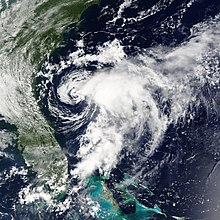
Back Tormenta tropical Edouard (2002) Spanish طوفان گرمسیری ادوارد (۲۰۰۲) Persian Tempête tropicale Edouard (2002) French 2002年热带风暴爱德华 Chinese
 Tropical Storm Edouard at peak intensity on September 3 | |
| Meteorological history | |
|---|---|
| Formed | September 1, 2002 |
| Dissipated | September 6, 2002 |
| Tropical storm | |
| 1-minute sustained (SSHWS/NWS) | |
| Highest winds | 65 mph (100 km/h) |
| Lowest pressure | 1002 mbar (hPa); 29.59 inHg |
| Overall effects | |
| Fatalities | None |
| Areas affected | Florida |
| IBTrACS | |
Part of the 2002 Atlantic hurricane season | |
Tropical Storm Edouard was the first of eight named storms to form in September 2002, the most such storms in the North Atlantic for any month at the time.[1] The fifth tropical storm of the 2002 Atlantic hurricane season, Edouard developed into a tropical cyclone on September 1 from an area of atmospheric convection associated with a cold front east of Florida. Under weak steering currents, Edouard drifted to the north and executed a clockwise loop to the west. Despite moderate to strong levels of wind shear, the storm reached a peak intensity of 65 mph (105 km/h) on September 3, but quickly weakened as it tracked westward. Edouard made landfall on northeastern Florida on September 5, and after crossing the state it dissipated on September 6 while becoming absorbed into the larger circulation of Tropical Storm Fay.[2]
Florida received moderate rainfall from Edouard, with floods exceeding 7 inches (180 mm) in the western portion of the state. Though Edouard was a tropical storm at landfall, wind speeds along the storm's path over land were light. The rain flooded several roads; however, there were no casualties, and damage was minimal.
- ^ Lixion Avila; Jack Beven; James Franklin (2002). "Summary of Tropical Cyclone Activity for September 2002". National Hurricane Center. Retrieved December 11, 2006.
- ^ Cite error: The named reference
tcrwas invoked but never defined (see the help page).